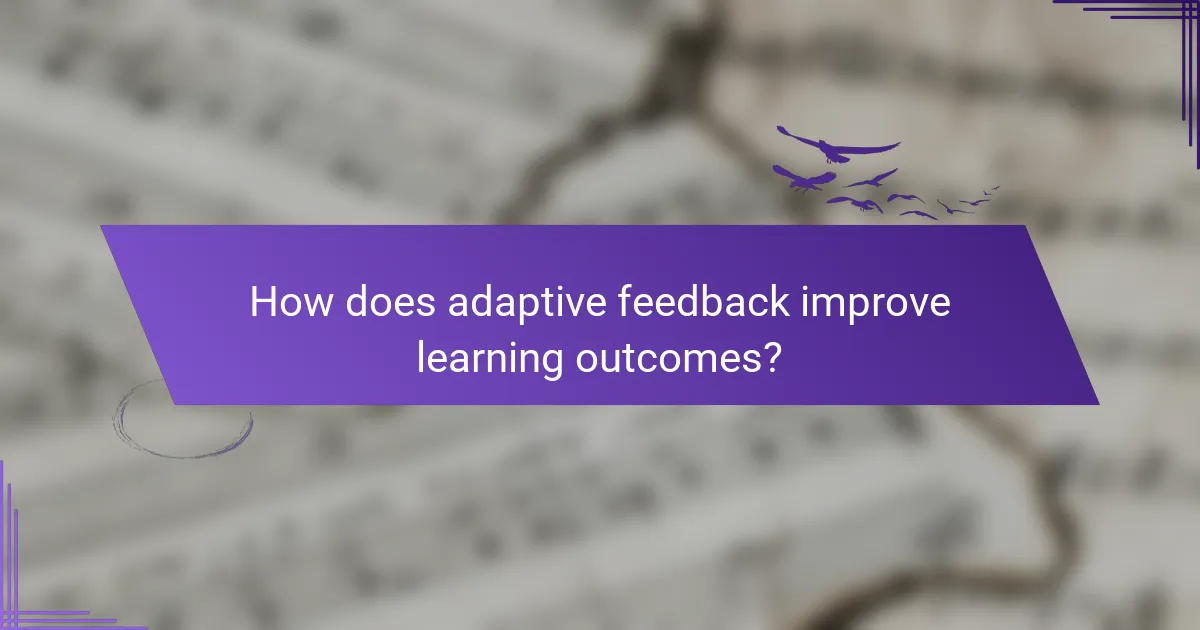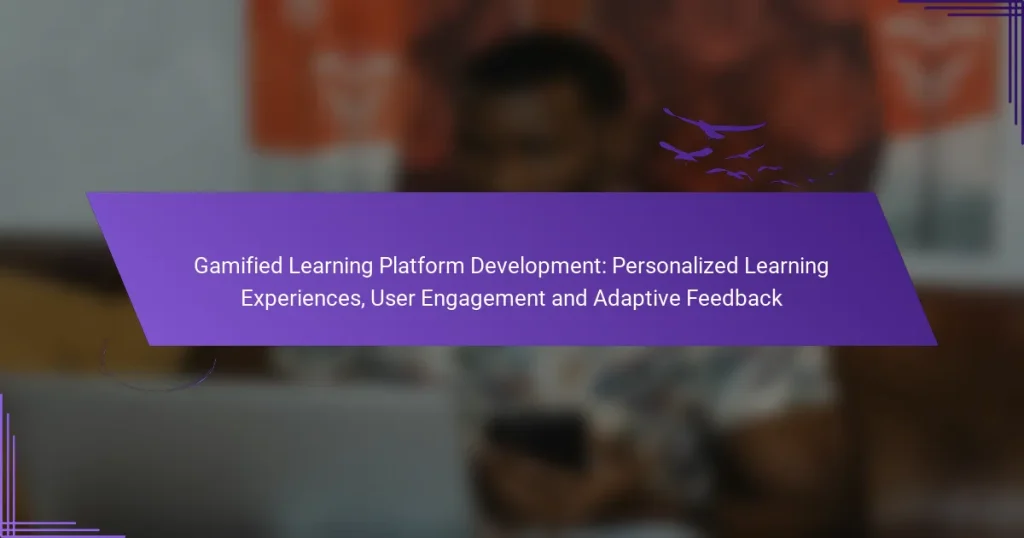Gamified learning platforms revolutionize education by integrating game-like elements that boost user engagement and motivation. By offering personalized learning experiences tailored to individual needs, these platforms utilize adaptive learning paths and customizable content to enhance effectiveness. Additionally, adaptive feedback provides learners with targeted responses, helping them to understand their mistakes and improve their skills.

How can gamified learning platforms enhance user engagement?
Gamified learning platforms enhance user engagement by incorporating game-like elements that motivate learners and create interactive experiences. These platforms leverage competition, rewards, and feedback to keep users actively involved in their learning journey.
Increased motivation through game mechanics
Game mechanics such as points, badges, and leaderboards significantly boost motivation among users. By setting clear goals and providing tangible rewards for achievements, learners are more likely to stay committed to their educational tasks. For instance, earning a badge for completing a module can encourage users to progress further.
Additionally, incorporating levels or challenges can create a sense of accomplishment, prompting users to strive for higher achievements. This structured progression mirrors the experience of playing a game, making learning more appealing and enjoyable.
Real-time feedback and rewards
Real-time feedback is crucial in gamified learning as it allows users to understand their performance immediately. Instant notifications about progress or areas needing improvement help learners adjust their strategies effectively. For example, a platform that provides instant feedback on quiz results can guide users to focus on weaker subjects.
Moreover, rewarding users for completing tasks or reaching milestones reinforces positive behavior and encourages continued engagement. Rewards can range from virtual currency to unlocking new content, creating a cycle of motivation and achievement.
Social interaction and competition
Social interaction and competition are key components of gamified learning platforms that enhance user engagement. Features like discussion forums, team challenges, and peer comparisons foster a sense of community among learners. Engaging with peers can motivate users to participate more actively and share knowledge.
Competition, whether through leaderboards or timed challenges, adds an element of excitement. Users often strive to outperform their peers, which can lead to increased effort and better learning outcomes. However, it’s essential to balance competition to ensure it remains healthy and encourages collaboration rather than discouragement.

What are the key features of personalized learning experiences?
Personalized learning experiences focus on tailoring educational content and methods to meet the individual needs of each learner. Key features include adaptive learning paths, customizable content and assessments, and user-driven learning objectives, all designed to enhance engagement and effectiveness.
Adaptive learning paths
Adaptive learning paths adjust the educational journey based on a learner’s progress and performance. This approach uses algorithms to analyze data and modify the difficulty and type of content presented, ensuring that learners remain challenged yet not overwhelmed.
For example, if a student excels in math but struggles with reading, the platform can increase math challenges while providing additional reading support. This flexibility promotes a more efficient learning process, allowing students to advance at their own pace.
Customizable content and assessments
Customizable content and assessments allow educators and learners to modify learning materials according to specific preferences and requirements. This feature can include selecting topics, adjusting the complexity of questions, or incorporating multimedia elements to cater to different learning styles.
For instance, a science module might offer options for visual, auditory, or kinesthetic learning activities, enabling students to engage with the material in a way that suits them best. This personalization can lead to improved retention and understanding of the subject matter.
User-driven learning objectives
User-driven learning objectives empower learners to set their own goals, fostering a sense of ownership over their education. This feature encourages students to identify what they want to achieve, whether it’s mastering a specific skill or completing a project.
By allowing learners to define their objectives, platforms can create a more motivating environment. For example, a student might choose to focus on improving their coding skills, leading to tailored resources and assessments that align with their aspirations. This approach not only enhances engagement but also encourages self-directed learning.

How does adaptive feedback improve learning outcomes?
Adaptive feedback enhances learning outcomes by providing personalized responses that address individual learner needs. This tailored approach helps students understand their mistakes and guides them toward better comprehension and skill mastery.
Immediate correction of misconceptions
Immediate correction of misconceptions is crucial for effective learning. When learners receive prompt feedback on errors, they can quickly adjust their understanding and avoid reinforcing incorrect knowledge. For example, if a student misinterprets a math problem, instant feedback can clarify the mistake, allowing them to grasp the correct concept before moving on.
To implement this effectively, gamified learning platforms can use real-time analytics to identify when a learner struggles with specific content. By flagging these issues immediately, the platform can provide corrective feedback that is both informative and supportive.
Tailored suggestions for improvement
Tailored suggestions for improvement provide learners with specific strategies to enhance their skills. Instead of generic advice, adaptive feedback systems analyze performance data to recommend targeted resources or exercises that align with the learner’s unique challenges. For instance, if a student consistently struggles with grammar, the platform can suggest focused practice activities to address those weaknesses.
To maximize the effectiveness of tailored suggestions, it’s essential to regularly update the learning pathways based on ongoing assessments. This ensures that the feedback remains relevant and continues to meet the evolving needs of the learner, ultimately fostering a more engaging and effective learning experience.

What technologies are essential for developing gamified learning platforms?
Developing gamified learning platforms requires a combination of technologies that enhance user engagement and personalize learning experiences. Key technologies include Learning Management Systems (LMS), artificial intelligence for personalization, and game design frameworks.
Learning Management Systems (LMS)
Learning Management Systems are crucial for organizing and delivering educational content in a gamified format. They provide a structured environment where learners can access materials, track progress, and engage with interactive elements.
When selecting an LMS, consider factors like user interface, integration capabilities, and support for gamification features such as badges and leaderboards. Popular LMS options include Moodle, Canvas, and Blackboard, each offering unique functionalities to enhance learning experiences.
Artificial Intelligence for personalization
Artificial intelligence plays a vital role in creating personalized learning experiences by analyzing user data and adapting content to meet individual needs. AI can assess a learner’s strengths and weaknesses, providing tailored feedback and recommendations.
Implementing AI requires careful consideration of data privacy regulations, especially in regions like the EU where GDPR applies. Tools like chatbots and adaptive learning algorithms can significantly enhance user engagement by offering real-time support and customized learning paths.
Game design frameworks
Game design frameworks help developers create engaging and interactive learning experiences by applying principles of game mechanics. These frameworks guide the integration of elements such as points, levels, and challenges into educational content.
When choosing a game design framework, assess its flexibility, ease of use, and compatibility with your chosen LMS. Popular frameworks include Unity and Construct, which allow for the development of immersive learning environments that motivate users through gameplay elements.

What are the prerequisites for successful gamified learning platform development?
Successful gamified learning platform development requires a clear understanding of user demographics, well-defined learning objectives, and robust technical infrastructure. These elements ensure that the platform meets the needs of learners while providing an engaging and adaptive experience.
Understanding user demographics
Understanding user demographics is crucial for tailoring the gamified learning experience. Factors such as age, educational background, and learning preferences influence how users interact with the platform. For instance, younger users may prefer more interactive and visually engaging content, while older learners might appreciate straightforward, text-based materials.
Gathering demographic data can be done through surveys, user profiles, and analytics tools. This information helps in designing personalized learning paths that resonate with different user segments, ultimately enhancing engagement and retention.
Defining learning objectives
Defining clear learning objectives is essential for guiding the development of a gamified platform. Objectives should be specific, measurable, achievable, relevant, and time-bound (SMART). For example, a platform might aim to improve users’ math skills by 20% within three months through interactive challenges.
These objectives not only inform content creation but also help in assessing user progress. Regularly revisiting and adjusting these goals based on user feedback and performance data can lead to better outcomes and a more effective learning experience.
Technical infrastructure and support
A strong technical infrastructure is vital for supporting a gamified learning platform. This includes reliable hosting, scalable architecture, and integration with learning management systems (LMS). Choosing the right technology stack can significantly impact the platform’s performance and user experience.
Additionally, ongoing technical support is necessary to address issues promptly and ensure smooth operation. Regular updates and maintenance can help keep the platform secure and aligned with the latest educational technologies and user expectations.

What are the best practices for user engagement in online courses?
Effective user engagement in online courses hinges on interactive content, personalized learning paths, and timely feedback. Implementing these strategies can significantly enhance learner motivation and retention.
Personalized Learning Experiences
Personalized learning experiences cater to individual learner needs, preferences, and pace. By utilizing data analytics, platforms can adapt content and assessments based on user performance and engagement levels. This customization can lead to improved outcomes and satisfaction.
For instance, a gamified platform might offer different challenges based on a user’s skill level, ensuring that learners are neither overwhelmed nor bored. Incorporating user profiles that track progress can further enhance personalization.
User Engagement Techniques
To boost user engagement, incorporate interactive elements such as quizzes, polls, and discussion forums. These features encourage active participation and create a sense of community among learners. Regular updates and fresh content also keep users returning.
Consider implementing gamification elements like badges or leaderboards to motivate learners. These techniques can foster a competitive spirit and encourage users to complete courses, enhancing overall engagement.
Adaptive Feedback
Adaptive feedback provides learners with immediate, relevant responses to their actions, helping them understand their strengths and areas for improvement. This feedback can be automated through algorithms that analyze user interactions and performance.
For example, if a learner struggles with a particular topic, the platform can offer additional resources or alternative explanations. This timely support can prevent frustration and promote a growth mindset, ultimately leading to better learning outcomes.


